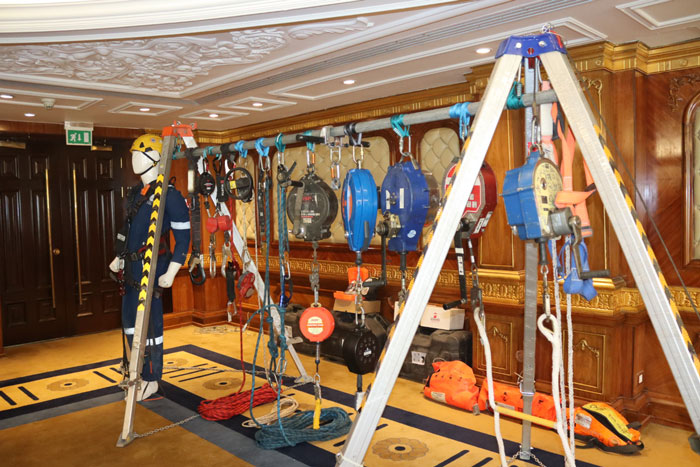
The specific Rescue gears list required depends on the type of rescue operation, the environment, and the potential hazards involved. Here’s a general list of rescue gear that may be used in various rescue scenarios:
Personal Rescue gears list (PPE)
Personal Rescue gears list, also considered as Personal Protective Equipment (PPE) for rescue scenarios, includes equipment designed to protect individuals involved in rescue operations. The specific gear needed can vary based on the nature of the rescue (e.g., confined space, high-angle, water rescue). Here’s a general list of PPE commonly used in various rescue situations:
Helmet: Provides head protection from falling objects, impacts, and other hazards.
Eye Protection: Safety glasses or goggles to protect against debris, dust, or chemical splashes.
Hearing Protection: Earplugs or earmuffs for noise reduction in noisy rescue environments.
Rescue gears list from gloves Depending on the specific hazards:
Cut-resistant gloves.
Heat-resistant gloves.
Chemical-resistant gloves.
Foot Protection: Safety boots with steel toes and shank for foot protection in various terrains.
High-Visibility Clothing: Increases visibility in low-light conditions or areas with moving vehicles.
Rescue Harness: Full-body harness with attachment points for fall protection and rescue.
Lanyard: Connects the harness to an anchor point, providing fall protection.
Descender and Ascender: Allows controlled descent (descender) or ascent (ascender) on ropes.
Rescue gears list: Harnesses and Fall Protection
Here’s a Rescue gears list commonly used for harnesses and fall protection:
Full-Body Harness:
Designed to distribute fall forces across the shoulders, thighs, and pelvis.
Includes attachment points for connecting to fall arrest systems.
Fall Arrest Lanyard:
Connects the harness to an anchor point or lifeline.
Designed to absorb energy in the event of a fall.
Shock Absorber:
Component often integrated into fall arrest lanyards to reduce impact forces on the body.
Positioning Lanyard:
Used to support a worker in a suspended position while allowing hands-free work.
Retractable Lifeline:
Offers freedom of movement with a retractable line that automatically adjusts.
Anchor Points:
Fixed points to which fall protection equipment is attached.
Examples include anchor straps, D-rings, and anchor slings.
Rescue Harness:
Specialized harness designed for use in rescue scenarios.
Often includes additional attachment points and features for rescue operations.
Rescue Ladder:
Enables workers to climb back to a safe position after a fall.
Rescue Pulley System:
Used for raising or lowering a worker during a rescue operation.
May include mechanical advantage systems for easier lifting.
Ropes and Rigging Equipment
Ropes and rigging equipment are crucial for Rescue gears list a variety of applications, including climbing, rescue operations, and industrial work. Here’s a list of common ropes and rigging equipment:
Dynamic Rope: Designed to stretch to absorb the energy of a fall, commonly used in climbing and mountaineering.
Static Rope: Minimal stretch, ideal for applications where limited elongation is needed, such as rescue operations.
Climbing Rope: Dynamic rope specifically designed for rock climbing and mountaineering.
Rigging Rope: Ropes designed for various rigging applications in industries such as construction and forestry.
Throw Line: Lightweight and compact rope used for throwing and creating temporary anchor points.
Accessory Cord: Small-diameter cordage used for various purposes, such as prusik loops, equipment attachment, or backup systems.
Prusik Cord: A small-diameter cord used for creating friction hitches and ascending/descending ropes.
Webbing: Flat or tubular woven fabric used for slings, anchor systems, and load distribution.
Slings: Circular loops of webbing or cordage used for creating anchor points and extending protection.
Carabiners: Rescue gears list used for connecting various components of the rigging system.
Pulleys: Mechanical devices used to redirect the force in a rope, often used for creating mechanical advantage systems.
Rescue Devices
Rescue gears list devices play a critical role in ensuring the safety of individuals during emergency situations. Here is a list of common rescue devices:
Throw Bags:
Small bags containing a length of rope, thrown to a person in the water or a difficult-to-reach location for rescue purposes.
Lifebuoys/Ring Buoys:
Floating devices with an attached rope, used for water rescue to provide buoyancy and aid in reaching and retrieving individuals.
Rescue Tubes:
Flotation devices designed to support a person in the water, often used by lifeguards for water rescue.
Rescue Boards:
Floatation boards used for aquatic rescues, especially in open water or swift currents.
Rescue Sleds:
Sled-like devices designed for water rescue, pulled by rescuers or boats to reach and retrieve individuals.
Rescue gears list: Communication Equipment
Communication equipment is crucial in rescue operations to ensure effective coordination and communication among rescue teams. Here’s a list of common communication equipment used in rescue operations:
Two-Way Radios: Portable two-way radios are essential for short-range communication among team members.
Satellite Phones: In remote areas with no or limited cellular coverage, satellite phones provide reliable long-distance communication.
Cellular Phones: Smartphones with robust cellular coverage are useful for communication in areas with network access.
Radio Repeaters: Repeaters extend the range of two-way radios, helping to overcome obstacles and increase communication coverage.
Signal Flares: Visual signals like signal flares are important for alerting others to your location, especially in low-light or remote areas.
Emergency Sirens: Sirens can be used to attract attention and signal the need for evacuation or alerting people to danger.
Loudspeakers: Portable loudspeakers can be used for amplifying important messages in crowded or noisy environments.
Rescue Megaphones: Megaphones are useful for projecting loud and clear voice commands or instructions in rescue situations.
GPS Devices: Global Positioning System (GPS) devices help in accurate location tracking and navigation, crucial for coordinating rescue efforts.
Multi-Channel Scanners: Scanners allow monitoring of various communication channels, including emergency services, to stay updated on unfolding situations.
Intercom Systems: In situations where there’s a need for communication within a confined space, intercom systems can be valuable.
Lighting Equipment
Lighting equipment is crucial in Rescue gears list, especially in low-light or dark environments. Proper illumination enhances safety and efficiency. Here’s a list of lighting equipment commonly used in rescue operations:
Headlamps: Hands-free lighting is essential for rescue workers. Headlamps provide a focused beam of light and allow for greater mobility.
Emergency Flares: Emergency flares can provide intense, short-term illumination and serve as distress signals. They are particularly useful in signaling for help.
Glow Sticks: Chemically activated glow sticks are lightweight, portable, and provide a low-level illumination for extended periods without the need for batteries.
Area Lights: Large, portable area lights with multiple LED bulbs are suitable for lighting up work zones or incident scenes.
Helmet Lights: Attachable lights for helmets provide directed illumination where the wearer is looking, which is beneficial in hands-on tasks during rescue operations.
Scene Lighting Systems: Portable lighting systems designed for larger areas, such as incident scenes or temporary command posts, often include multiple light heads and adjustable stands.
Intrinsically Safe Lights: In environments with potentially explosive gases or flammable materials, intrinsically safe lights are designed to minimize the risk of ignition.
Rescue Light Sticks: Specialized light sticks designed for rescue operations may include features such as attachment clips or hooks for hands-free use.
Emergency Exit Signs: In indoor environments, illuminated emergency exit signs help guide people to safety during evacuations.
Medical Equipment
Medical equipment is a critical component of rescue operations, as it allows first responders to provide necessary medical care to individuals affected by emergencies or disasters.
The compilation of the Rescue Gears List is a top priority in the collaboration between CLC Company and Egyptes Company. It will be discussed in detail at the event.


